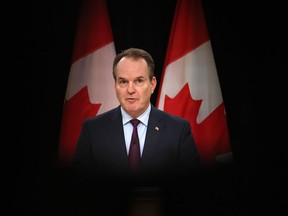The Bank of Canada is out-hawking the Fed over inflation it largely created itself
Article content
By Dylan Smith
The Bank of Canada is looking for clear evidence of “further and sustained downward momentum in core inflation” before it considers cutting interest rates. That was the message governor Tiff Macklem addressed directly to markets in a press availability after his annual year-end speech on Dec. 15.
Article content
To get there, the governor is also looking for further wage growth moderation and an easing in shorter-term inflation expectations. That’s a lot less dovish than United States Federal Reserve chair Jerome Powell’s press conference earlier in the week, though there was a clear effort to make the Bank of Canada’s position feel more neutral than in prior meetings.
Advertisement 2
Article content
Macklem referred several times to a “balanced” outlook with “risks on both sides.” But when pushed explicitly by reporters on the fact that mortgage costs (which directly reflect the central bank’s base rate setting) are the main factor keeping inflation up, the governor emphasized that core inflation (including shelter) is the target of the Bank of Canada. That’s a comment designed to send a hawkish message as it implies convergence to core only after base effects wash out in the third quarter of 2024 (in line with the central bank’s forecast).
Macklem’s somewhat hawkish tone was consistent with European Central Bank and Bank of England communications on Dec. 14. There is a clear effort from central banks to lean against the massive easing in financial conditions unleashed by the Fed last week. Even the Fed itself has mildly rebuked markets, with Federal Reserve Bank of Cleveland president Loretta Mester saying on Dec. 18 that markets are a “bit ahead” of the central bank. That’s natural after such a strong market move, even a well-justified one.
Central bankers hate all forms of volatility, and we would fade further containment efforts. But what’s surprising to us is the discrepancy that’s opened between the Fed , the ECB and the Bank of Canada. Markets are pricing 70 per cent odds of a Fed cut in March, but only around 40 per cent for both Canada and the euro area. That reverses the fundamentals: the downturn in the cycle is only just setting in the U.S., but has been underway for some time in Canada and Europe and with some severity. Inflation is lower outside the U.S., too.
Advertisement 3
Article content
All this argues for a repricing of the relative timing and pace of cuts between central banks; the Fed should be seen as a backstop for Canada and Europe, the latest point at which they would cut (they would be loath to induce a demand-killing currency appreciation). But the fundamentals point to earlier cuts in both economies, and we wouldn’t be surprised if that pans out.
Indeed, Macklem appears to have picked up on the hawkish taste he left in investors’ mouths last week because after the market close on Dec. 18, he made a TV appearance in which he reiterated the main thrust of his message on what he needs to see on inflation, but added the marginally dovish comment that cuts would therefore be appropriate “sometime in 2024.”
Related Stories
-

The Fed just woke up and smelled the recession
-

Only inflation left to tame is being caused by Bank of Canada itself
-

Canada’s menacing mortgage math means crisis looming
From our perspective, it is borderline outrageous that the Bank of Canada would be so consumed with inflation that it is largely responsible for: strip out the mortgage costs from the consumer price index and the inflation rate is pretty much at target. That’s the dirty little secret that rarely, if ever, gets any attention.
Dylan Smith is vice-president and senior economist at independent research firm Rosenberg Research & Associates Inc., founded by David Rosenberg. To receive more of David Rosenberg’s insights and analysis, you can sign up for a complimentary, one-month trial on the Rosenberg Research website.
Article content
Secret about inflation and Bank of Canada that rarely gets attention
2023-12-19 17:54:42






